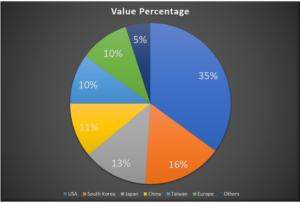ABC of Chip War: Chips, semiconductors, integrated circuits are terms used interchangeably. Although their meaning is different. Term chip or microchip is widely understood. Those who have seen supply chain disruptions in their businesses, or have been affected by delayed or rolled back automotive productions, or have seen price hikes in consumer goods; Chip war is something they may have heard of specially in COVID-19 pandemic world. This article is about ABC of Chip War.
What are they?
What are chips? Chris Miller in his book, Chip War: The Fight For World’s Most Critical Technology, defines it succinctly. According to him, the entire digital universe consists of two numbers 1 and 0. This binary system is the core of computing. These numbers do not exist physically. These are in fact expressions of the electric current. 1 is on, 0 is off.
A Chip is a grid of millions of transistors that perform the function of a switch between 1 and 0 to generate a distinct code for everything such as an email, a video, a voice note, a QR code, or a key on a keyboard itself.
Most chips are made of silicon wafers. Silicon is the second most abundant element in the world. Silica sand is one of the major sources of extracting Silicon. Silicon Valley in the USA is named so because of its association with silicon. Germanium, silicon carbide, gallium nitride and other elements are also used in Chip manufacturing. However, silicon is most widely used.
In 1961, a San Fransisco based company named Fairchild Semiconductors launched a new product called Micrologic, a silicon chip with only 4 transistors. Apple’s iPhone 14 had 11.8 billion transistors.
According to Washington based organization semiconductors.org, today’s semiconductors are so advanced they can contain more than 100 billion transistors on a single piece of silicon. It would take a person more than 1,000 years to count each one aloud.
Chip Classification
In Semiconductor industry, chips are classified into different categories in terms of types and their functions. Logic, Memory, and Analogue are major types.
Logic chips are also called brains of electronic devices. Microprocessors such as Central Processing Unit (CPU) or Graphics Processing Unit (GPU) that power even supercomputers. Logic chips can also be designed for a particular task such as operating an automatic blind in a living room. Communications industry, automotive sector, computing and Internet of Things (IoT) devices are major drivers of their demand.
Memory chips are for storing data. Data is stored in two forms: short term and longer term. There are two primary types of Memory chips. Dynamic Random Access Memory (DRAM) and Not-And (NAND). DRAM is used to store data temporarily. Random access allows processors to access any part of the memory rather than having to proceed sequentially from the starting point. Simply, it makes it much faster. Like when the processor is booting a system it uses code from RAM. NAND, used for longer-term data storage, for example photographs, email correspondence and so on. These remain stored even when a device is switched off.
Analog chips are used to convert analog signals into digital signals. They have wide applications. Broadly they are used for environment monitoring, electrical power management, communications and surveillance systems.
Size Matters
The Semiconductor industry has used ‘node’, a term used to define successive generations of a particular chip. “Node” represents the actual size of transistor gates on logic chips. These were measured in metric scale; whose size has now reached nanometers.
When smaller became expensive, the market turned to other solutions such as 3D layers, however, ‘node’ remained in use. Now it is a marketing term, where smaller numbers means greater performance.Times Magazine has reported on IBM’s 2-nm tech that puts 50 billion transistors inside a chip.
TSMC Taiwan and Samsung South Korea have announced plans to produce the 2 nm chips by 2025. For comparison, a human blood cell is 7000 nm.
Stages of Chip Production
Stage-1: Research is the first step in Chip production. Research is typically undertaken by design firms, manufacturers, Integrated Device Manufacturers (IDMs) and Universities. This is where STEM importance lies. This is also where the intellectual property, commercial and security espionage issues come into play.
Stage-2: Second stage is the design. Just as an architect designs a building, chips are designed. This stage involves blueprints and design software. Here also design algorithms, software and hardware licensing issues exist.
Stage-3: The designs are then carved into silicon wafers. This is called fabrication. Using some of the world’s most precise machinery. Which can etch, deposit, and measure layers of materials a few atoms thick. These are primarily made by five companies, one Dutch, one Japanese and three Americans. Without these tools advanced chips cannot be made. The Dutch company ASML is the only company in the world that builds extreme ultraviolet lithography (printmaking process) machines, without which cutting-edge chips are simply impossible.
Stage-4: Assembly, Test, and Packaging (ATP). After fabrication, wafers are usually sent to other facilities for ATP. Here, chips are cut from the silicon wafer, tested for performance, and packaged.
Why are Chips Important?
According to semiconductors.org, semiconductors (or chips) are the brain of modern electronics. They are essential for all electronic items. Automation, AI, 5G/6G, IoT, computing power, space, defense, medical technologies and so on all rely more and more on these chips. Data is called oil in the AI world. Actually, it is the computing power that matters. To build that computing power chips are essential.
Geopolitics, Geo-economics and Chips
Semiconductors.org State of Industry Report of 2022 indicates chip industry value by activity and region. Overall U.S.A. leads.

If this is the state of market, where majority share is with U.S.A and other friendly countries and merely 11% with China. Than why the Chip War? What is the purpose of targeting Huawei and introduction of Chips and Science Act in U.S.A? Why China has been investing heavily in semiconductor manufacturing technology? Like maritime ‘choke points’ are there chip-choke points? Are there any supply chain issues or its politics at play? ABC of Chip War – Part II – Geopolitics, Geo-economics and Chips will have the answers.
About the author.







2 Responses
Excellent read sir. Very Weldone for your analysis sir. Indeed with China banning government officials from the use of iPhones for official purposes to the mass investment in semiconductor technology, the future of ‘Chips war’ would be quite an interesting one.
I laughed so hard at ‘chip-choke point’ 😄. I believe, sir, that it’s more of politics at play rather than supply chain issues, which I think would have attendant impact, not only between the 2 nations but ultimately for the entire world.
Looking forward to the Part II sir.